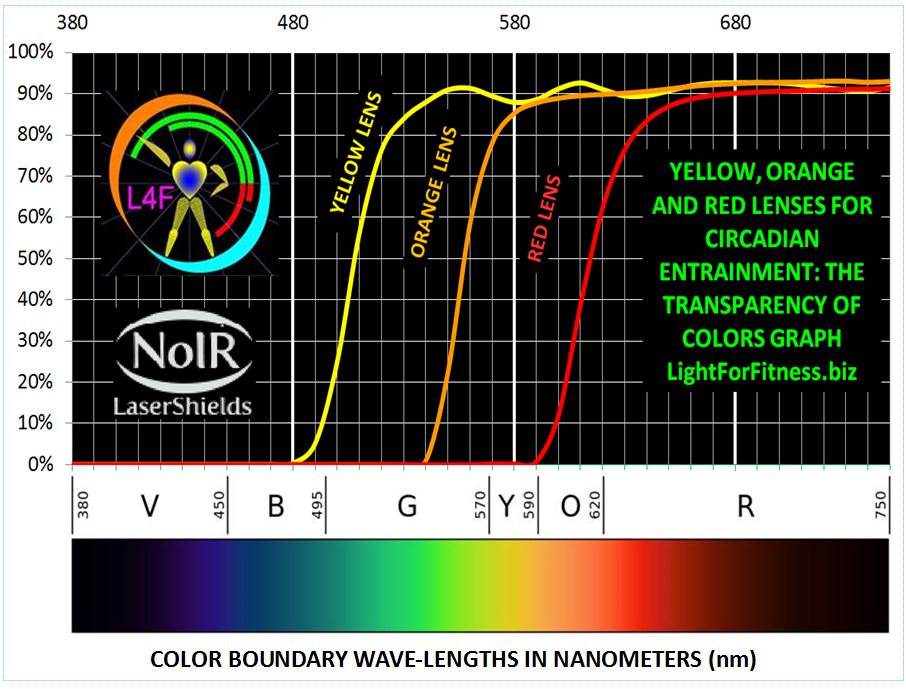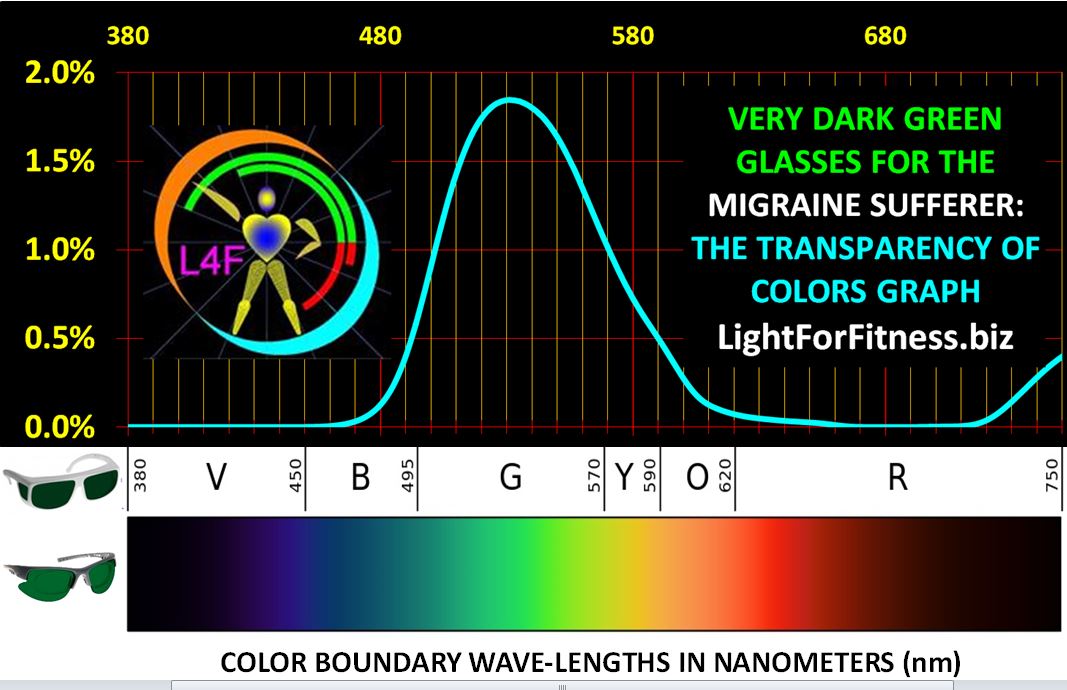MAIN MENU scroll down to read the right lens color?
- ABOUT my transformation
- VIDEO TESTIMONIALS Light-Hygiene
- NEWS and EVENTS about Light For Fitness
- OUR EFFORTS toward Research
- BLOG Posts and Comments
- SCIENTIFIC PAPERS (Doubt? Read!)
- EXPLANATIONS OF TECHNICAL TERMS
- how to use – MELATONIN ONSET EYEWEAR – simple plan
- WHY?
- Why use our melatonin onset eyewear?
- Can I just turn off the BLUE PIXELS and skip wearing the orange glasses? NOPE!
- LINKS
- BUY! ENTER STORE FRONT DOOR LightForFitness.biz
how to use – MELATONIN ONSET EYEWEAR – simple plan scroll down to read the right lens color?
THE RIGHT LENS COLOR?


the right lens color?
What lens color is best for melatonin glasses: RED or ORANGE or YELLOW? The answer depends on your lifestyle and environments. The explanation below will help you determine which color lens will work the best for you.
The earliest research employing colored lens glasses demonstrated that yellow lens eyewear worked well to preserve evening dim light melatonin onset. Such yellow lens eyewear worked because it blocks the majority of the blue portion of light contained in white light. Blue light hitting the retina prior to sleep time is considered the most circadian disruptive color.
Since the time of this early research, much brighter indoor artificial light sources have come into existence.
Today there are bluer-richer white light LED lamps and brighter computer screens, cell phones and TVs. These modern improvements with their enhanced blue-ness and overall greater brightness begs another question for it is also true that the green light portion contained within white light can also disrupt dim light melatonin onset (when green is bright enough), in the same way the blue portion does.
Hence, should modern melatonin glasses that are in use indoors prior to sleep time, also block green light?
Blue light is the most disruptive color to prevent pre-sleep melatonin onset and green light is the second most disruptive color prior to sleep time, contained in white light.
This is why most eyewear recommended today to prevent circadian disruption contains orange lenses, because such a lens SHOULD block both all of the blue light and more than half of the green light contained in white light (an accurate statement about blocking when using LightForFitness Orange Eyewear and not accurate for other Orange eyewear).
Thus, an orange lens provides more assurance that the lens will preserve evening dim light melatonin onset better than a yellow lens would. But, for certain persons and situations the orange lens may be too dark, thus having the option to use a yellow lens in darker situations is a good strategy.
For evening purposes I use the orange lens when I will be using a computer, cell phone or watching large screen TV, but if I am doing work around the house in partially lit rooms the yellow lens is a better idea to avoid the stubbing of the toes.
When taking into account all the colors of the visible spectrum, the orange lens is about 50% transparent overall and the yellow lens about 70% overall, which is why the yellow lens is better for darker situations (an accurate statement for LightForFitness Yellow Lens Eyewear and LightForFitness Orange Lens Eyewear but might not be true for other yellow and orange lens eyewear).
Orange and yellow lenses are adequate to protect against typical evening indoor artificial light sources, but these lenses may not block enough of the green light and yellow light portion contained in bright direct natural outdoor sunlight for the Night-Shift-Worker. The Night-Shift-Worker during ride home might encounter the morning sunrise light while still hopefully preserving his morning entrained melatonin onset and then attempt daytime sleep shortly after arriving home.
(NOTE: His bedroom needs to be kept very dark to preserve pineal gland melatonin onset and to maintain melatonin in the blood stream).
This is why the usage of a red lens might be the right choice for the Night-Shift-Worker. The red lens blocks most of the yellow portion and the entire green portion and all of blue portion of light contained in white light, and is therefore the darkest lens of the three colored lenses, mentioned above, with about a 9% transparency overall (an accurate statement about LightForFitness Red Lens Eyewear, but may not be true for other red lens eyewear).
The yellow light portion contained within white light is the third place color that can cause circadian disruption prior to sleep-time, if it is bright enough. Blue is most disruptive, green is less and yellow the lesser, or in other words a person can tolerate much more yellow light than green and much more green than blue light before succumbing to circadian disruption.
Thus, here is my simple selection guide to fit how you live and the specific environments you encounter.
An orange lens may work perfectly or partially for all situations but if a person needs to sleep mere hours after seeing direct bright morning sunlight, I suggest that the dark red lens, for morning usage, will give them more assurance of morning melatonin onset preservation. And for indoor evening usage, an orange lens will likely always work well to preserve melatonin onset, but this lens might place toes in danger of stubbing in areas of inadequate brightness.
Starting with the orange lens will likely get most persons well equipped for most situations, but it is a good idea to be open to also consider red and yellow lenses depending on the scope of one’s environments.
So I would suggest owning both yellow lens and orange lens eyewear for evening indoor use for a typical night time sleeper.
But, for the night-shift-day-time-sleeper I would suggest owning both orange lens eyewear (to be worn a couple of hours before the night shift ends while working indoors), and then red lens eyewear during the trip home outdoors.
For the night-shift-worker, if the indoors work environment is too dark for the orange lens, then use a yellow lens instead. If the trip home during sunrise is overcast and gray but still not dark, try the orange lens instead of the red lens.
Consequently, because I suggest owning at least two different lens colors, I sell dual lens eyewear.
For the night-shift-worker-day-time-sleeper, I sell eyewear that has an orange lens in the main with a red flip lens; also I sell eyewear with a yellow lens in the main with a flip red lens.
For the typical night time sleeper I sell eyewear with a yellow lens in the main, with an orange flip lens, which eyewear might also work well for a night-shift-worker-day-time-sleeper, if both the work place is somewhat dark with no computer screen usage and the outdoor environment has sunrise but is overcast.
I hope this clarifies why dim light melatonin onset eyewear can come in three different color lenses.
Below are my links to these kinds of eyewear.
FOR NIGHT SHIFT WORKER: ORANGE & RED DUAL LENS EYEWEAR
FOR NIGHT SHIFT WORKER: YELLOW & RED DUAL LENS EYEWEAR
FOR NIGHT SHIFT WORKER: All RED LENS EYEWEAR
FOR NIGHT SHIFT WORKER AND OR TYPICAL NIGHT TIME SLEEPER ALL YELLOW & ORANGE DUAL LENS EYEWEAR
FOR NIGHT SHIFT WORKER AND OR TYPICAL NIGHT TIME SLEEPER All ORANGE LENS EYEWEAR
FOR TYPICAL NIGHT TIME SLEEPER ALL YELLOW LENS EYEWEAR
FOR TYPICAL NIGHT TIME SLEEPER AND MIGRAINE SUFFERER YELLOW & GREEN DUAL LENS EYEWEAR
FOR MIGRAINE SUFFERER ALL GREEN LENS EYEWEAR
how to use – MELATONIN ONSET EYEWEAR – simple plan scroll up to read the right lens color?
MAIN MENU scroll up to read the right lens color?
- ABOUT my transformation
- VIDEO TESTIMONIALS Light-Hygiene
- NEWS and EVENTS about Light For Fitness
- OUR EFFORTS toward Research
- BLOG Posts and Comments
- SCIENTIFIC PAPERS (Doubt? Read!)
- EXPLANATIONS OF TECHNICAL TERMS
- how to use – MELATONIN ONSET EYEWEAR – simple plan
- WHY?
- Why use our melatonin onset eyewear?
- Can I just turn off the BLUE PIXELS and skip wearing the orange glasses? NOPE!
- LINKS
- BUY! ENTER STORE FRONT DOOR LightForFitness.biz